
Contents





A Magician Who Works Miracles






Splendor of Autumn in Jangseong
A Long Leisurely Walk on Foot
Ride along a quiet, tree-lined road in the countryside, stretching below a deep blue cloudless sky. The cool breeze sends ripples through the golden fields, while beautiful villages form small groups below the mountain. The persimmon tree in one corner of the yard is heavy with deep orange persimmons. In a yard, an elderly villager is drying peppers, dyed deep red by the autumn sun. A cat enjoying the autumn sunshine on the wall stretches lazily. These unremarkable scenes, comforting in their warmth, are from Jangseong, the northernmost point of Jeollanam-do Province. Let’s take an autumn trip to Jangseong, where the comforts and wonders of nature are to be found all around.
Written by Baek Suji Photographed by Studio Kenn
Illustrated by Hagogo
Chungnyeongsan Cypress Forest In Search of My Own Forest
The Chungnyeongsan area is thickly forested with over 2.5 million 50-year-old cypresses, cedars and other conifers covering a vast area of 1,148 hectares. The Chungnyeongsan cypress forest is one of Korea’s largest manmade forests, grown by famous forest manager Chunwon Lim Jongguk (1915-1987) over 21 years, making it a ‘forest of tenacity.’
Our hike began at the parking lot in Chuam Village near Jangseong-eup. Before reaching the actual forest trail, we had a 20-minute walk uphill, until we reach a roadblock to prevent vehicles from entering. Two hundred meters from there is Lim Jong-guk’s memorial stone. Beside the memorial stone, there’s a hiking path to the peak of Chungnyeongsan Mountain. Everyone seemed to find the hike quite manageable, with the cooling autumn breeze drying away breaking sweat. Aside from the cypresses, the forest is home to many other tree species such as cedar and larch. Most notable are the thick and straight firmiana trees, looking almost like bamboo from a distance, growing so tall a phoenix may come to nest. A variety of ferns and moss have spread out over the tree roots, making it seem like we have entered the depths of a jungle.
 Standing tall and firm, a cypress tree provides a rest stop for hikers.
Standing tall and firm, a cypress tree provides a rest stop for hikers.Many trails have been created in the cypress forest, allowing for slow and leisurely strolls. While the Health Trail leads to the observation deck at the peak of Chungnyeongsan Mountain, the Forest Scent Trail goes along the cypress forest and marsh park walking trails, offering ample opportunity to breath in the phytoncide from the trees. Interestingly, the path is lined with cypress pellets, making it softly cushioned. Walking slowly along the forest trail, it feels like our bodies are absorbing the refreshing scent of the cypress.
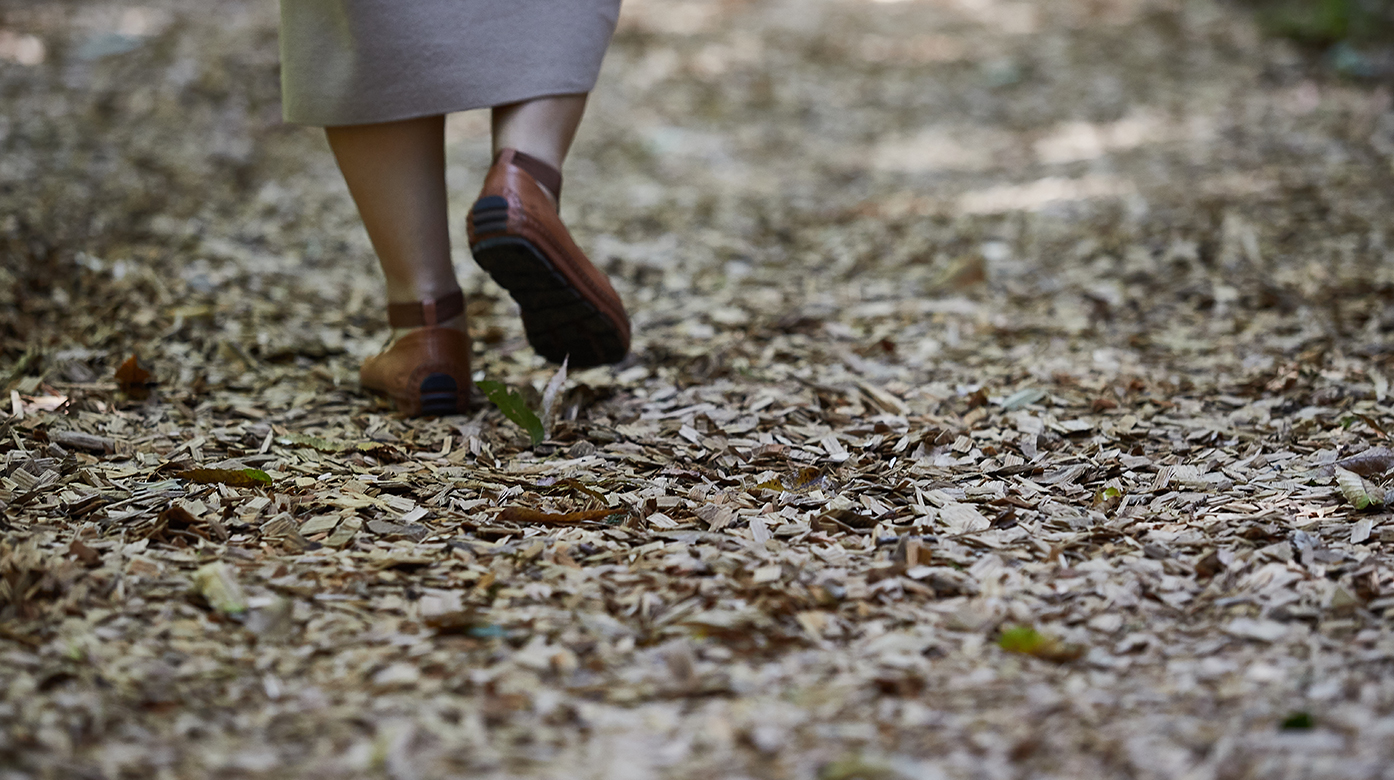 Stepping on the fallen dried leaves of a cypress tree brings a nutty and earthy smell.
Stepping on the fallen dried leaves of a cypress tree brings a nutty and earthy smell.Jangseongho Lake Resort Small but Certain Happiness
Walking up the stairs after parking at Jangseong Dam, we see Baegamsan Mountain far in the distance. This is where the Jangseongho Lakeside Trail begins. This is a 7.5 km long trekking course between Jangseongho Dock and Suseong-li in Bukyimyeon. It seems to be a popular choice among families with children, who enjoy the sights and sounds of both forest and lake at the same time. Every now and then, a tree branch stretches over the deck, providing shade from the autumn sun, and giving a glimpse of maple leaves turning red. At the end of the decked trail is a small pavilion, where visitors can rest. It’s a good idea to stop and sit for a while, as the uphill trail begins from here. Although the slope is not steep, it is a naked forest trail, where you have to step over tree roots and rocks. There’s no reason to hurry; you can go at your own pace. As the path is narrow, stop from time to time to let people pass in the opposite direction, sit on a rock every now and then, taking in the view of the lake. Walking along the forest trail, you will be greeted by a surprising sight. This is the Yellow Swinging Bridge, the highlight of the trail, located about 1.2 km from the starting point. The swinging bridge stretches across the lake, symbolizing the rise of Jangseong-gun, with 21-meter high columns designed like yellow dragons erected at its two ends. The entire bridge is yellow, true to Jangseong-gun’s nickname “Yellow City.”
Crossing the bridge as it sways with each step is a thrilling experience, like walking on water. It is a popular photo spot, and many people stop halfway to take pictures. The center of the bridge is where it sways and wobbles the most, not only up and down, but also left and right.
 The place seems to be a popular choice among families with children, who enjoy the sights and sounds of both forest and lake at the same time.
The place seems to be a popular choice among families with children, who enjoy the sights and sounds of both forest and lake at the same time. The calm lake of Baekyangsa Temple and Baekamsan Mountain standing firm behind it creates beautiful scenery.
The calm lake of Baekyangsa Temple and Baekamsan Mountain standing firm behind it creates beautiful scenery.Baegyangsa Temple A Painting Over the Water
Baegyangsa Temple is a temple of long history, built in the Baekje era. It is also the Korean temple with the most foreign visitors, who come to participate in the Baegyangsa Temple Stay program. Some background knowledge about the history of Baegyangsa Temple will make your visit even more meaningful. Baegyangsa Temple was established in the 33rd year of King Mu of Baekje, 1,400 years ago, and is the birthplace of Honam Buddhism in southwest province of Korea. At the time of its founding, it was called Baegamsa Temple, but the name was changed to Baegyangsa Temple by Monk Hwangyang in the 7th year of King Seonjo of Joseon. The name “Baegyangsa” means “White Sheep Temple,” after the legend that a white sheep received enlightenment at the temple. A white sheep statue is placed under the autumn olive tree in the temple for this reason as well.
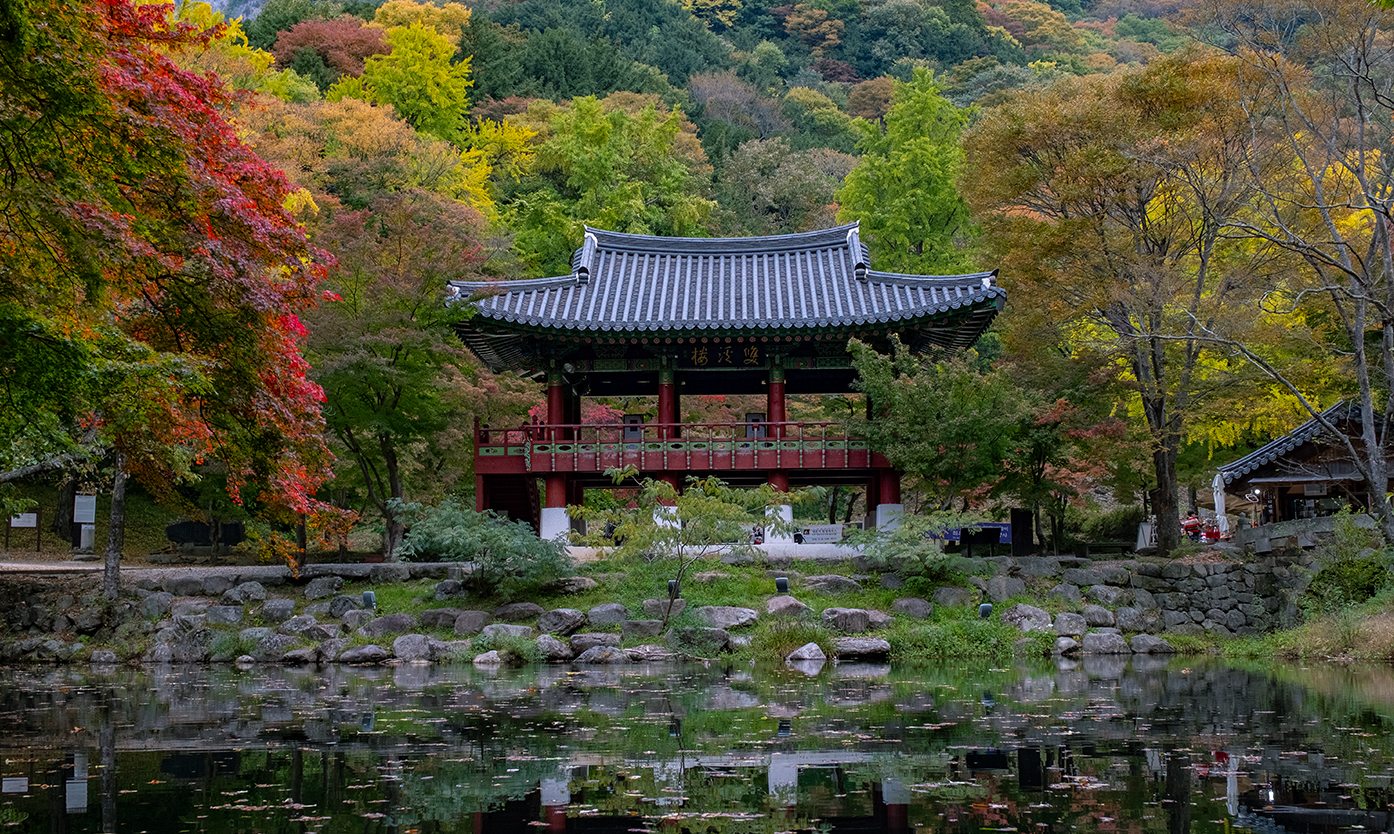 Pass the wood path of lined-up white oaks and maple trees, through the entrance of Baekyangsa Temple, and you will first spot Ssanggyeru. You will appreciate the breathtaking view of Ssangyeru shimmering in the pond.
Pass the wood path of lined-up white oaks and maple trees, through the entrance of Baekyangsa Temple, and you will first spot Ssanggyeru. You will appreciate the breathtaking view of Ssangyeru shimmering in the pond.Baegyangsa is famous for the beautiful sight of Ssanggyeru Pavilion reflected in the pond. Colorful autumn leaves and the Ssanggyeru Pavillion are set against the majestic backdrop of Baegamsan Mountain and reflected in the pond, providing a glimpse of paradise in the water. A special feature of the maple trees here is their small leaves, earning the nickname ‘baby maple,’ as the leaves are as small as a baby’s hand. Although they are small, their color is a uniquely intense and beautiful crimson. Autumn reaches its peak when the baby maples display this enchanting color. That is when it will get crowded here, with visitors out to bask in the glory of late autumn. Autumn visitors can enjoy the harmony of colorful leaves embroidered overhead and beneath their feet, capturing the beauty of fall in their cameras and eyes.
Trip Points
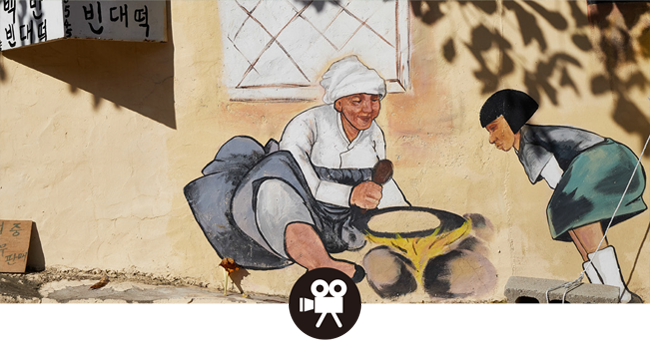
Geumgok Cinema Village The Harmonium in My Memory
The Cinema Village, famous as the location for the movie “The Harmonium in My Memory,” is located in Geumgok Village. It was first discovered by director Im Gwon-taek as a location for the movie “The Taebaek Mountains.” Since then, it’s been used as the location for director Kim Su-yong’s “Scent of Love” and MBC drama series “The Boss.” The village is located deeper in the valley than expected. Water babbles along the small stream, and traditional Jangseung poles greet visitors at the entrance. The sight of the persimmon tree branches heavy with fruit, white smoke rising from the chimneys, humble terraced fields, and the horse mill in the center of the village inspire strong nostalgia for days almost forgotten.
The buildings of Geumgok Village are now mostly used as guesthouses and movie sets. Only a few people continue to live here. However, if you want to steep in the memories of old movies, nostalgia for childhood days, and the charms of a mountain village, this would be the place.

Hwangnyonggang River Yellow Flower Festival A Picture to Remember
You are a step closer to the fields of Namdo. This is the way to Hwangnyonggang Ecopark, also known as Korea’s longest “Flower River.” This is because the Yellow Flower Festival has been ongoing since mid-October. The river of flowers unfolds before you as soon as you park. Over a billion autumn flowers such as orange cosmos, zinnia and sunflowers line the bank of the vast Hwangnyonggang River.
The path is organized into different gardens with their own themes. Sunshine Garden is a sunflower garden, with a wide range of sunflower varieties that follow the movements of the sun. Flower Light Garden is the main garden, divided into the several zones, with offerings to delight all five senses. Moonlight Garden is where visitors can make wishes upon the moon over Hwangnyonggang River. In one corner, there is a field of pink muhly grass, currently trending on social media, creating a dreamlike and exotic scene. The air is filled with shutter sounds, as no one wants to leave without capturing all these sights.
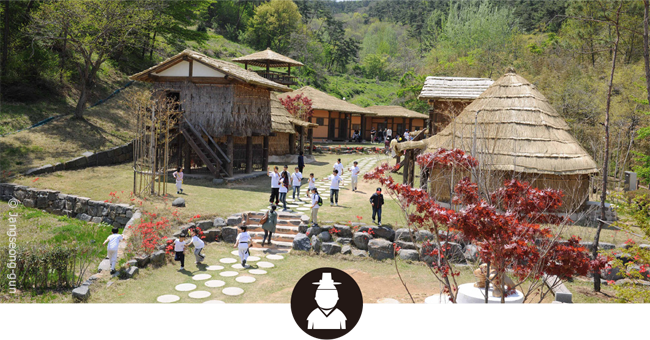
Hong Gildong Theme Park The Dreams of Hong Gil-dong, the Korean Superhero
Hong Gil-dong is indisputably the most iconic figure of Jangseong-gun. It is definitely a point of pride that Hong Gil-dong, the hero who rejected the discrimination he faced as a concubine’s son, and who stole from corrupt officials and those in the ruling classes and gave to ordinary people suffering from poverty was born in Jangseong.
Walk up a little from there to reach the Hwalbindang Lodge, a reproduction of Hong Gil-dong’s fortress in Museongsan Mountain, Gongju, which was the final hiding place of Hong and his friends. Heading out from the lodge and crossing the bridge over a small valley, we reach a reproduction of Hong Gil-dong’s home. In another corner, there is a Korean traditional archery arena, where visitors can pick up the bow and arrow and try for a bullseye.

Yowol Pavilion Garden Garden Where Scholars Invited the Moon
The name Yowol means to invite the moon, and to invite the moon means to invite friends and poetry. Eminent figures of the time visited the pavilion on the bank of Hwangnyonggang River, enjoying gentle company and reciting poetry. At the entrance to the path to Yowoljeong Pavillion, on the left, is Hwangnyongjeong.
The pavilion is surrounded by a pine forest and some sixty 100-year old crape myrtle trees, adding to the beauty. The crape myrtle trees are the main attraction in this forest. The pavilion is guarded by some strong crape myrtle trees, which create a fantastic sight in summer when the crimson flowers bloom. Although the crape myrtle trees are all bare branches for now, the deep green pine forest on the hill behind the pavilion offer consolation for the absence of flowers.
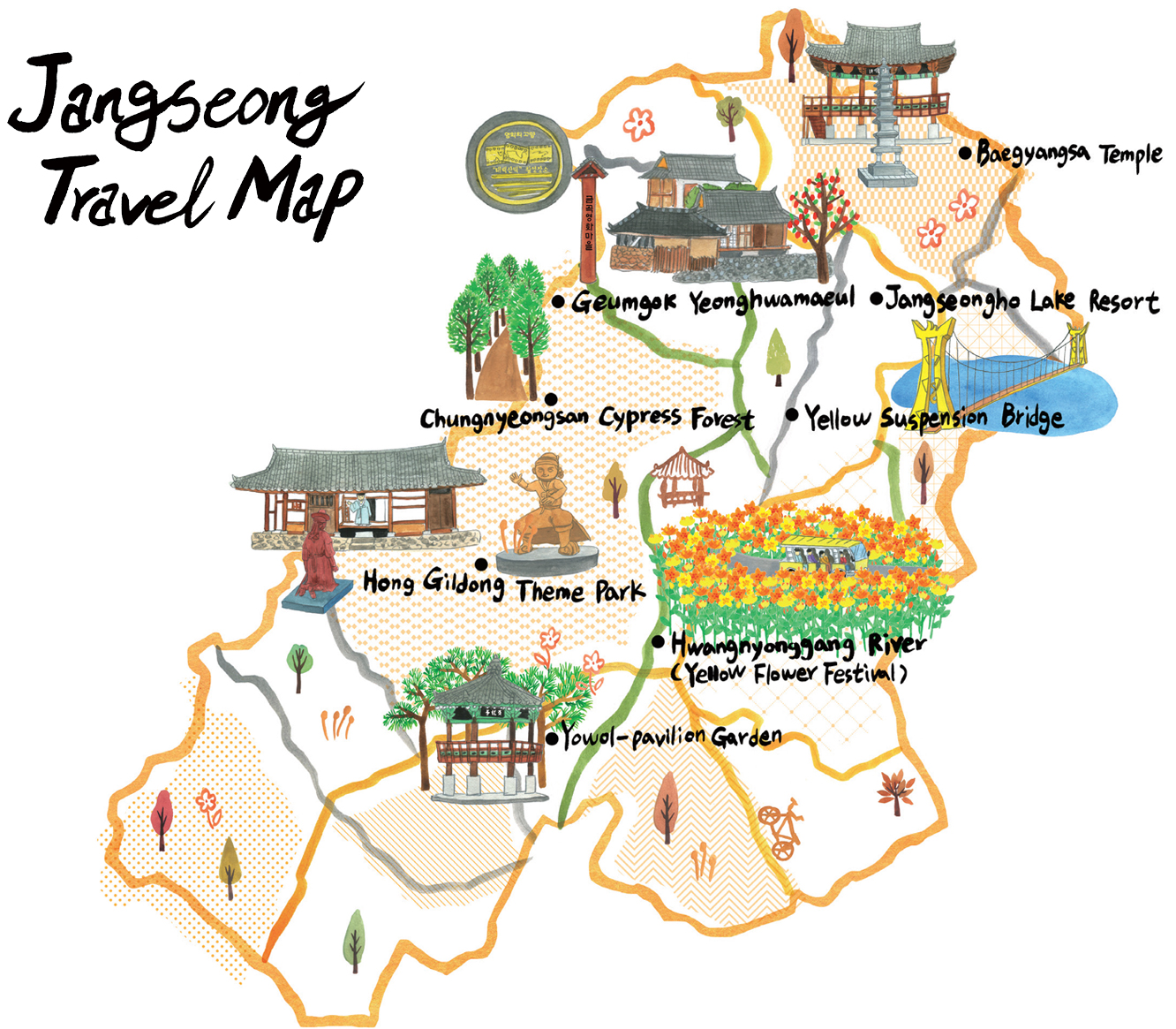
Travel Tip
-
Jangseong Tourism Information Desk
- Address : 200, Yeongcheon-ro, Jangseong-eup, Jangseong-gun, Jeollanam-do
- Tel : +82-61-390-7241
- Hours : 09:00-18:00
Chungnyeongsan Cypress Forest
- Address : (Moam Parking Lot) 682, Moam-ri, Seosam-myeon, Jangseong-gun, Jeollanam-do (Chuam Parking Lot) 664, Chuam-ri, Seosam-myeon, Jangseong-gun, Jeollanam-do
- Tel : +82-61-393-1777(1778) -
Korea Travel Hotline
- Tel : 1330
Jangseongho Lake Resort
- Address : 591-8, Baegyang-ro, Bukha-myeon, Jangseong-gun, Jeollanam-do
- Tel : +82-61-392-7248Baegyangsa Temple
- Address : 1239, Baegyang-ro, Bukha-myeon, Jangseong-gun, Jeollanam-do
- Tel : +82-61-392-7502Baegyangsa Temple Stay Program
- Tel : +82-61-392-0434
- E-mail : baekyangsa@templestay.com -
Hwangnyonggang River
- Address : 461-1, Gisan-ri, Jangseong-eup, Jangseong-gun, Jeollanam-do
Hong Gildong Theme Park
- Address : 431, Honggildong-ro, Hwangnyongmyeon, Jangseong-gun, Jeollanam-do
- Tel : +82-61-392-7242
- Hours : 09:00-18:00Geumgok Yeonghwamaeul
- Address : 254-7, Yeonghwamaeul-gil, Bugil-myeon, Jangseong-gun, Jeollanam-do
Yowol-pavilion Garden
- Address : 58-53, Yowoljeong-ro, Hwangnyongmyeon, Jangseong-gun, Jeollanam-do
- Tel : +82-61-390-7225
Other Articles





A Magician Who Works Miracles





Application of subscription
Sign upReaders’ Comments
GoThe event winners
Go


 November 2018
November 2018


